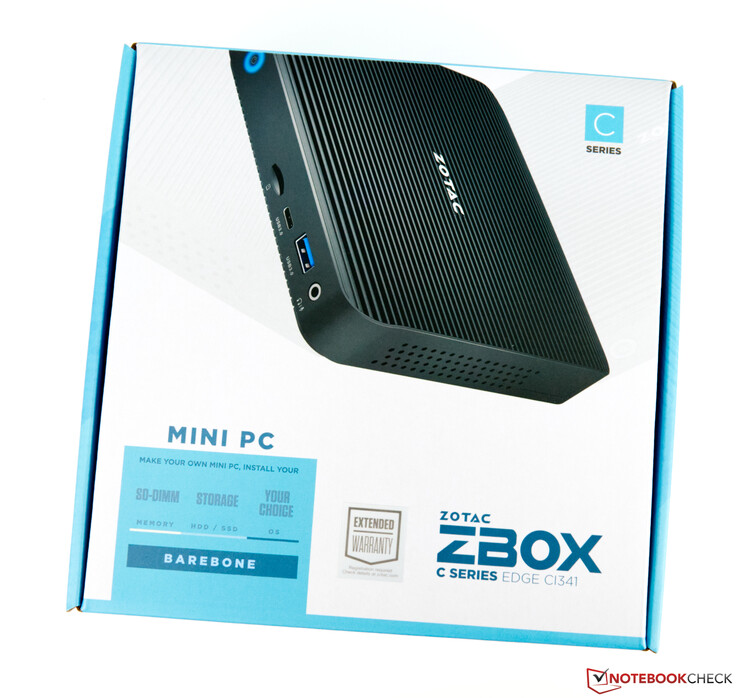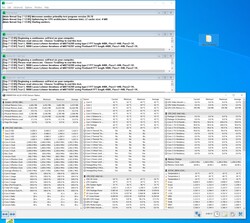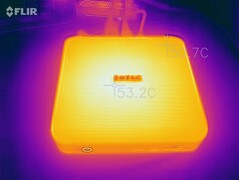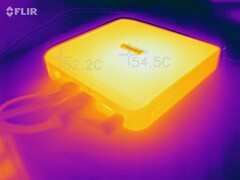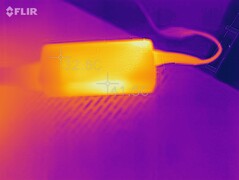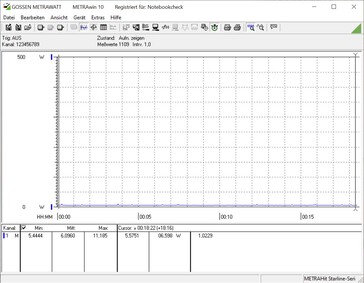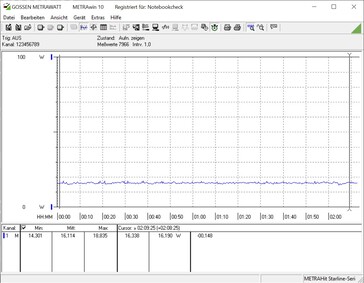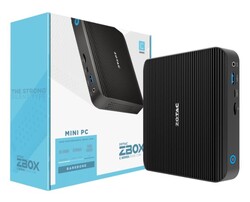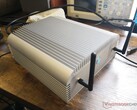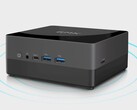Affordable Zotac ZBOX edge mini PC in review

The Zotac C series' edge is based on an Intel Gemini Lake SoC with a very low TDP of only 6 watts, which enables passive cooling. The Intel Celeron N4100 has a base clock speed of 1.1 GHz and reaches up to 2.4 GHz under load. The quad-core processor is sufficient for simple office tasks. Despite the passive cooling, the mini PC is very slim at just 32 millimeters. Conversely, this also means that there's no room for a 2.5-inch drive in its interior. Instead, an M.2 mass storage drive is used, but that shouldn't be a problem at all. When it comes to RAM, users have the option of equipping the barebone with two SO-DIMM modules.
The Zotac ZBOX edge can be found on the shelves of various online stores for just under 200 Euros (~$242). However, you have to keep in mind that this is a barebone system. This means that you have to buy the storage device, memory modules, and a license for the operating system separately.
The mini PC offers a solid basis in terms of connections. A total of three USB ports allow connecting various external devices. However, one of them is installed as a Type-C port, which somewhat restricts the use of common USB devices when a mouse and keyboard already need to be connected. Furthermore, there is dual-Gigabit LAN and an SD card reader. In addition, displays can be connected via HDMI or DisplayPort. A Wi-Fi 5 module is available for wireless network connections, and it also supports Bluetooth 4.2 at the same time. The box includes a small 40-watt power adapter as well.
Case and connectivity
The case of the Zotac ZBOX edge is mainly made of plastic and aluminum. The device leaves a high-quality impression, both in terms of looks and feel. If you want to equip the barebone, you have to remove the underside, which is easy. The SSD and RAM can be installed quickly, and the device is ready for use after installing the operating system.
Performance - Enough for everyday work
The Zotac ZBOX edge is a very energy-efficient office system. The Intel Celeron N4100 is specified with a TDP of only 6 watts; consequently, it doesn't need an active cooling unit. The quad-core SoC is sufficient for simple office tasks. For the test, we equipped the mini PC with 16 GB of RAM and a 256 GB SSD. However, it should be noted that only SATA SSDs are supported. Unfortunately, faster NVMe SSDs can't be used.
Processor
A mobile SoC with four Atom-based cores and four threads serves as processor. This makes the small PC ideally suited for multi-threaded applications for daily office use. The Intel Celeron N4100 has a base clock speed of 1.1 GHz, and it reaches up to 2.4 GHz via Turbo.
In the test, the energy-efficient SoC was able to achieve sufficient performance and a better average result. Compared to the more powerful Core i5 SoCs, however, our test sample has to admit defeat by a considerable margin. Due to the low TDP of only 6 watts, the SoC can't provide more performance. We could not determine a higher power consumption of the Intel Celeron N4100 under load in our test device.
| Blender - v2.79 BMW27 CPU | |
| Average Intel Celeron N4100 (2437 - 3527, n=7) | |
| Zotac ZBOX EDGE CI341, Intel Celeron N4100 | |
| Lenovo ThinkBook 15 , Intel Core i5-10210U | |
| Intel NUC10i5FNK, Intel Core i5-10210U | |
* ... smaller is better
Cinebench R15 Multi loop
The load test with the Cinebench R15 Multi loop shows that the cooling system doesn't have any problems with the low TDP of the hexa-core processor. Here, the first result shows the run with the best possible Turbo utilization, which is only present for a short time, though. After the first run, the result settles at a stable level.
System performance
The small mini PC from Zotac performs well in the synthetic benchmarks. However, performance varies based on the installed components, so better results might be achieved with RAM that runs in dual-channel mode. The subjective impression is reflected in the test result. Therefore, users shouldn't expect too much from the ZBOX edge, because it could otherwise lead to short waiting times.
Graphics card
The system doesn't come with a dedicated graphics card. Instead, it uses the Intel UHD Graphics 600 iGPU. 4K displays can be run at 60 Hz using the two external ports, which is sufficient for office use. However, 3D performance is not really available, which is also evident in the benchmarks. Consequently, the system is not suitable for 3D games. Nevertheless, playing one or two casual or browser games should still be possible with the ZBOX edge.
| 3DMark 11 Performance | 673 points | |
Help | ||
| low | med. | high | ultra | QHD | |
|---|---|---|---|---|---|
| Dota 2 Reborn (2015) | 40.2 | 17.4 | 7.3 | 6.9 | |
| Final Fantasy XV Benchmark (2018) | 4.52 | 2.16 | 1.55 | 1.12 | |
| X-Plane 11.11 (2018) | 6.47 | 4.88 | 4.44 | ||
| Strange Brigade (2018) | 9.5 | 6.1 | 5.8 | 3.6 |
Emissions and energy
Temperature
Even under load, the temperatures of the Zotac ZBOX edge are always in the uncritical range. The surface of the case heats up a bit more than usual due to the passive cooling, but it's still acceptable at a good 54 °C (~129 °F). We register a temperature of 64 °C (~147 °F) for the SoC during the load test, which is also a normal value. We also measure a good value of 41 °C (~106 °F) for the power adapter under load.
Noise emissions
There are no emissions from active cooling components in the Zotac ZBOX edge. This makes silent use in the office possible. Even under load during the stress test or when accessing data on the installed SSD, we didn't notice any electronic noises or coil whine.
Energy consumption
Zotac can score well with the ZBOX edge in terms of energy consumption, since the very energy-efficient SoC only consumes a maximum of 6 watts under load. Naturally, the remaining components also need some energy, so that we documented an average of 16 watts in the stress test. In idle usage, the compact system is satisfied with an average of 6 watts. The included 40-watt power adapter is, therefore, completely sufficient.
Pros
Cons
Verdict - An energy-efficient office PC
The Zotac ZBOX edge mini PC is quite an interesting device when it comes to silent and very energy-efficient work. The Intel Celeron N4100 belongs to the Gemini Lake family and was able to deliver solid performance in the test that is above the average of our previously documented benchmark scores. The frugal quad-core CPU is sufficient for everyday office work if you don't feed it with too many tasks at the same time.
With the ZBOX edge, Zotac offers a very affordable yet high-quality barebone system for office use.
However, those who want to buy the system have to keep in mind that it's a barebone system. Consequently, the storage drive, RAM, and operating system still need to be installed. Therefore, the low purchase price, which is around 200 Euros ($179.99 on Amazon), becomes somewhat relative. In addition, the mass storage device has the particularity of only supporting SATA SSDs.
The design is simple, and there are no shortcomings in terms of build quality. The available ports offer a solid base, although we would have found the inclusion of a third USB Type-A port to make sense. The possibility to connect two displays is good as is the integrated SD card reader.




